The Hydrogen Pipeline Market is estimated to be valued at USD 7.6 billion in 2025 and is projected to reach USD 852.1 billion by 2035, registering a compound annual growth rate (CAGR) of 60.3% over the forecast period. The hydrogen pipeline market is expected to follow a transformative growth trajectory over the forecast period. Initial expansion is gradual, driven by pilot projects, early industrial applications, and the establishment of initial transport networks. This phase lays the groundwork for broader infrastructure development and stakeholder confidence.
In the mid-phase, growth accelerates significantly as large-scale pipelines are deployed to connect production hubs with industrial clusters, refueling stations, and power generation facilities. Expansion is reinforced by strategic partnerships and policy support targeting decarbonization and low-carbon energy integration. The later years demonstrate exponential adoption, with the widespread deployment of green hydrogen infrastructure and its integration into energy grids, mobility, and industrial applications. Year-on-year growth exhibits a steep upward curve, reflecting a shift from niche usage to mainstream deployment.
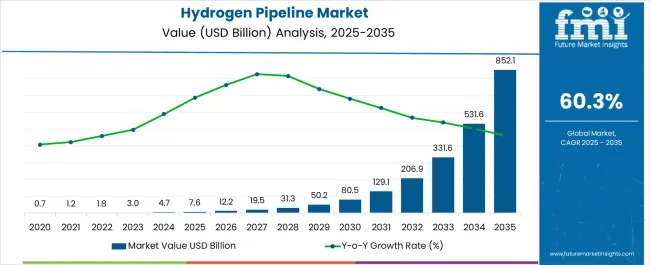
| Metric | Value |
|---|---|
| Hydrogen Pipeline Market Estimated Value in (2025 E) | USD 7.6 billion |
| Hydrogen Pipeline Market Forecast Value in (2035 F) | USD 852.1 billion |
| Forecast CAGR (2025 to 2035) | 60.3% |
The hydrogen pipeline market is witnessing robust development fueled by the global transition toward clean energy and decarbonization initiatives. Hydrogen is gaining prominence as a scalable energy carrier, and pipeline infrastructure is essential for its cost effective distribution over long distances.
Governments and industry players are investing in hydrogen pipeline networks to support industrial applications, mobility solutions, and cross border energy trade. Technological advancements in pipeline materials and safety systems are also enabling the efficient transport of both green and blue hydrogen.
Regulatory frameworks and national hydrogen strategies are accelerating deployment, especially in developed regions focused on achieving net zero emissions. The market outlook remains optimistic as hydrogen infrastructure becomes central to future energy systems, unlocking growth opportunities in production hubs and end use sectors alike.
The hydrogen pipeline market is segmented by type, classification, and geographic regions. By type, the hydrogen pipeline market is divided into Onshore and Offshore. In terms of classification, the hydrogen pipeline market is divided into New and Repurposed Pipelines. Regionally, the hydrogen pipeline industry is classified into North America, Latin America, Western Europe, Eastern Europe, Balkan & Baltic Countries, Russia & Belarus, Central Asia, East Asia, South Asia & Pacific, and the Middle East & Africa.
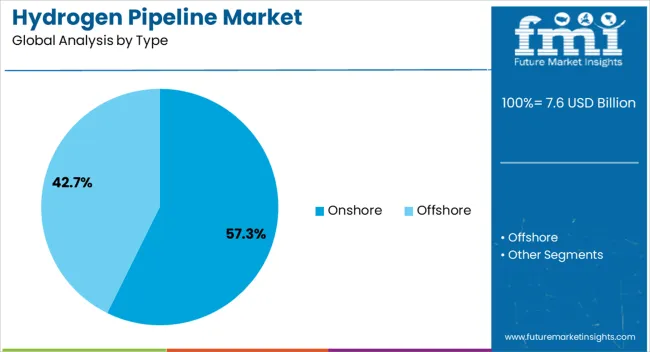
The onshore segment is projected to account for 57.30 % of the total market revenue by 2025 under the type category, establishing its position as the leading deployment mode. This dominance is driven by lower construction costs, streamlined permitting processes, and easier maintenance access compared to offshore counterparts.
Onshore pipelines are extensively used for transporting hydrogen between industrial production sites, refineries, and end-use facilities across regions with developed land-based infrastructure. Favorable land availability and reduced technical complexities have supported widespread deployment.
The reliability and scalability of onshore systems make them well-suited for national hydrogen grid development, reinforcing their stronghold in the overall market.
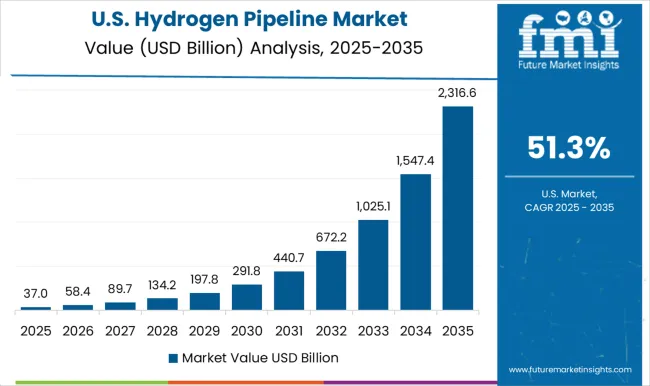
The new installation segment is expected to hold 62.10 % of market share within the classification category by 2025, positioning it as the dominant growth driver. This growth is propelled by rising demand for new hydrogen infrastructure to support expanding clean energy projects and mobility networks.
With most hydrogen pipelines still in the early stages of deployment, new build activity forms the core of industry investment. Strategic efforts by governments and private players to establish hydrogen corridors and export routes are contributing to the surge in new installations.
Additionally, technological improvements and favorable financing structures are accelerating project execution timelines. As the global hydrogen economy scales, new pipeline installations are expected to maintain their leadership, laying the foundation for long-term infrastructure development.
The hydrogen pipeline market is driven by clean energy demand and government support, with challenges related to costs and safety. Future growth opportunities are centered around emerging markets and technological improvements.
The hydrogen pipeline market is primarily driven by the global push for cleaner energy sources and the need to decarbonize heavy industries. Increased interest in hydrogen as a fuel alternative, especially for transportation and power generation, fuels the expansion of hydrogen infrastructure. National and regional policy support plays a significant role, with governments pushing for hydrogen as part of their energy strategies. Advancements in pipeline technology have made hydrogen transportation more cost-effective and secure. These factors collectively contribute to a growing need for reliable, large-scale hydrogen transportation networks to meet rising demand from both industrial sectors and consumers.
Despite its potential, the hydrogen pipeline market faces several challenges that hinder rapid growth. High initial investment costs in pipeline construction and maintenance are significant barriers for stakeholders. The market is also grappling with regulatory hurdles, as hydrogen infrastructure is subject to varying regulations across different regions. Safety concerns related to the transportation of hydrogen, such as leaks or explosions, have raised the need for stringent safety standards. Although technological solutions exist, the financial and operational complexities surrounding the construction of hydrogen pipelines need addressing to ensure large-scale adoption.
The hydrogen pipeline market presents numerous opportunities, particularly in emerging regions with growing industrial demands for clean energy. Several countries are accelerating their hydrogen adoption initiatives, leading to the expansion of hydrogen networks. This growth is further driven by the increasing production of green hydrogen, especially in areas with abundant renewable energy resources. The integration of hydrogen pipelines into existing infrastructure, including natural gas pipelines, offers a cost-effective solution to expand the hydrogen supply network. Strategic partnerships between energy companies and governments also provide a significant opportunity to scale up hydrogen infrastructure.
The hydrogen pipeline market is set to benefit from the rise in clean energy adoption globally. As more countries commit to reducing carbon emissions, the demand for hydrogen pipelines is expected to increase substantially. Governments and private entities are expected to invest more in expanding hydrogen networks, improving efficiency, and integrating renewable sources into the hydrogen production process. The market is also likely to see advancements in pipeline materials and techniques, further lowering the cost and improving the efficiency of hydrogen transportation. As a result, the market for hydrogen pipelines is anticipated to experience steady growth in the coming years.

| Countries | CAGR |
|---|---|
| China | 81.4% |
| India | 75.4% |
| Germany | 69.3% |
| France | 63.3% |
| UK | 57.3% |
| USA | 51.3% |
| Brazil | 45.2% |
The hydrogen pipeline market is projected to grow globally at a CAGR of 60.3% between 2025 and 2035, driven by increased hydrogen adoption across industries, investments in green hydrogen infrastructure, and government-backed initiatives. China leads with a CAGR of 81.4%, fueled by its ambitious clean energy targets, extensive industrial hydrogen demand, and large-scale infrastructure projects. India follows with a CAGR of 75.4%, supported by rising hydrogen adoption in the energy and transportation sectors and ongoing government initiatives to reduce carbon emissions. France records 63.3%, driven by its active commitment to hydrogen in decarbonizing its energy sector and expanding hydrogen networks for industrial and mobility applications. The United Kingdom grows at 57.3%, with significant investments in hydrogen infrastructure and technological innovations to support its transition to a low-carbon economy. The United States posts 51.3%, driven by increasing hydrogen production and pipeline infrastructure development, particularly for industrial and transport sectors. The analysis highlights Asia-Pacific’s leading role in hydrogen pipeline expansion, while Europe and North America focus on infrastructure development, regulatory support, and integration into broader energy transition strategies.
The hydrogen pipeline market in the UK is forecasted to achieve a CAGR of 57.3% during 2025–2035, rising from approximately 43.0% in 2020–2024, surpassing the global average of 60.3%. This increase is primarily driven by stronger government policies supporting hydrogen infrastructure development and ongoing efforts to decarbonize sectors like transportation and energy. The UK’s commitment to hydrogen as a key energy source for future industries is accelerating the development of hydrogen pipelines, particularly in heavy industries, power generation, and commercial transport. The adoption of green hydrogen technologies, along with collaborations between energy firms and governmental agencies, is further boosting the demand for hydrogen infrastructure.
China’s hydrogen pipeline market is forecasted to grow at a CAGR of 81.4% during 2025–2035, an increase from approximately 70% during 2020–2024. The significant growth is fueled by China’s national strategy to reduce carbon emissions and the rapid expansion of hydrogen infrastructure to integrate green hydrogen into various sectors. China’s commitment to hydrogen as a key energy source for future industries like transportation, chemicals, and power generation is further supported by government policies and massive investments in energy transition projects. These efforts include developing large-scale hydrogen pipeline networks to support hydrogen production from renewable sources.
India is projected to post a CAGR of 75.4% during 2025–2035, a rise from 62.3% during 2020–2024. This growth is attributed to India’s evolving hydrogen energy policies, aligned with its commitments under the Paris Agreement. The Indian government’s hydrogen mission, along with investments in large-scale hydrogen production and storage infrastructure, drives the expansion of hydrogen pipelines. The country is focusing on green hydrogen production, particularly in regions with high renewable energy potential. As industries like steel manufacturing and transportation transition toward hydrogen-based solutions, the demand for an extensive hydrogen pipeline network is rising.

The USA hydrogen pipeline market is set to grow at a CAGR of 51.3% during 2025–2035, up from 41.6% during 2020–2024. This increase reflects the ongoing expansion of the USA hydrogen infrastructure as the government intensifies its commitment to reducing carbon emissions by using alternative fuels like hydrogen. Hydrogen is gaining traction as a cleaner alternative in industrial sectors, transportation, and power generation, which accelerates the need for a robust hydrogen pipeline network. The shift toward zero-emission transportation, including hydrogen fuel cell vehicles, further drives the demand for hydrogen infrastructure.
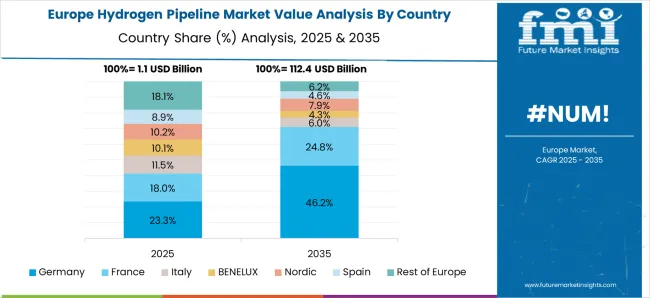
The hydrogen pipeline market in France is forecasted to grow at a CAGR of 63.3% during 2025–2035, an increase from 50.5% between 2020 and 2024. This growth is driven by France’s active role in decarbonizing its energy system, particularly hydrogen’s integration into power generation and transportation sectors. The French Hydrogen Plan has facilitated investments in both hydrogen production and transportation. With a focus on enhancing national hydrogen infrastructure, including pipeline systems, France is becoming a leader in green hydrogen within Europe. The significant market growth is a result of rapid advancements in hydrogen technology and stronger public-private partnerships.
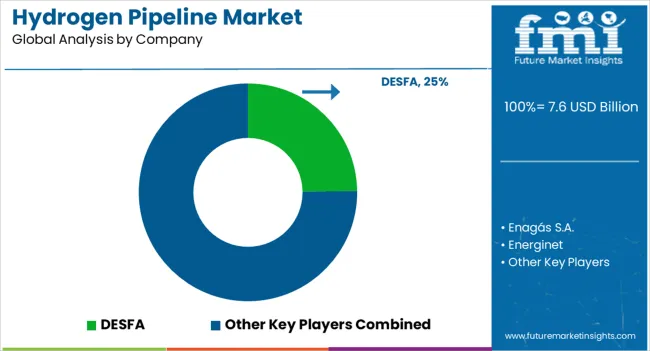
The hydrogen pipeline market is shaped by leading global energy and infrastructure companies such as DESFA, Enagás S.A., Energinet, Fluxys, Gasunie, GAZ-SYSTEM, GRTgaz, ONTRAS Gastransport GmbH, REN, Snam, Terega, and The ROSEN Group. These players compete through innovation in pipeline design, safety protocols, material technologies, and cost efficiency to support the expansion of hydrogen infrastructure. DESFA leads in the development and management of gas pipeline networks, while Enagás S.A. focuses on natural gas and hydrogen pipeline systems in Spain. Energinet and Fluxys offer advanced solutions for hydrogen transportation, emphasizing system integration and infrastructure optimization. Gasunie, GAZ-SYSTEM, and GRTgaz are major players in the European market, developing pipelines for both natural gas and hydrogen transmission.
ONTRAS Gastransport GmbH, REN, and Snam are significant contributors to pipeline expansion in Germany, Portugal, and Italy, respectively, through innovative approaches in hydrogen network integration. Terega and The ROSEN Group focus on pipeline inspection, maintenance, and safety, ensuring high operational standards. Competitive strategies center on forming long-term partnerships with energy providers and governments, as well as expanding infrastructure to accommodate green hydrogen. These companies are continuously working to integrate hydrogen pipelines with existing natural gas networks, facilitating the transition to cleaner energy solutions. Future competitiveness will depend on expanding pipeline capacity, improving safety, and optimizing hydrogen storage and transportation technologies.
| Item | Value |
|---|---|
| Quantitative Units | USD 7.6 Billion |
| Type | Onshore and Offshore |
| Classification | New and Repurposed |
| Regions Covered | North America, Europe, Asia-Pacific, Latin America, Middle East & Africa |
| Country Covered | United States, Canada, Germany, France, United Kingdom, China, Japan, India, Brazil, South Africa |
| Key Companies Profiled | DESFA, Enagás S.A., Energinet, Fluxys, Gasunie, GAZ-SYSTEM, GRTgaz, ONTRAS Gastransport GmbH, REN, Snam, Terega, and The ROSEN Group |
| Additional Attributes | Dollar sales, share by geographical segment, and emerging market trends, key drivers such as government regulations, energy transition goals, and increasing hydrogen adoption would be crucial for understanding demand. |
The global hydrogen pipeline market is estimated to be valued at USD 7.6 billion in 2025.
The market size for the hydrogen pipeline market is projected to reach USD 852.1 billion by 2035.
The hydrogen pipeline market is expected to grow at a 60.3% CAGR between 2025 and 2035.
The key product types in hydrogen pipeline market are onshore and offshore.
In terms of classification, new segment to command 62.1% share in the hydrogen pipeline market in 2025.






Our Research Products

The "Full Research Suite" delivers actionable market intel, deep dives on markets or technologies, so clients act faster, cut risk, and unlock growth.

The Leaderboard benchmarks and ranks top vendors, classifying them as Established Leaders, Leading Challengers, or Disruptors & Challengers.

Locates where complements amplify value and substitutes erode it, forecasting net impact by horizon

We deliver granular, decision-grade intel: market sizing, 5-year forecasts, pricing, adoption, usage, revenue, and operational KPIs—plus competitor tracking, regulation, and value chains—across 60 countries broadly.

Spot the shifts before they hit your P&L. We track inflection points, adoption curves, pricing moves, and ecosystem plays to show where demand is heading, why it is changing, and what to do next across high-growth markets and disruptive tech

Real-time reads of user behavior. We track shifting priorities, perceptions of today’s and next-gen services, and provider experience, then pace how fast tech moves from trial to adoption, blending buyer, consumer, and channel inputs with social signals (#WhySwitch, #UX).

Partner with our analyst team to build a custom report designed around your business priorities. From analysing market trends to assessing competitors or crafting bespoke datasets, we tailor insights to your needs.
Supplier Intelligence
Discovery & Profiling
Capacity & Footprint
Performance & Risk
Compliance & Governance
Commercial Readiness
Who Supplies Whom
Scorecards & Shortlists
Playbooks & Docs
Category Intelligence
Definition & Scope
Demand & Use Cases
Cost Drivers
Market Structure
Supply Chain Map
Trade & Policy
Operating Norms
Deliverables
Buyer Intelligence
Account Basics
Spend & Scope
Procurement Model
Vendor Requirements
Terms & Policies
Entry Strategy
Pain Points & Triggers
Outputs
Pricing Analysis
Benchmarks
Trends
Should-Cost
Indexation
Landed Cost
Commercial Terms
Deliverables
Brand Analysis
Positioning & Value Prop
Share & Presence
Customer Evidence
Go-to-Market
Digital & Reputation
Compliance & Trust
KPIs & Gaps
Outputs
Full Research Suite comprises of:
Market outlook & trends analysis
Interviews & case studies
Strategic recommendations
Vendor profiles & capabilities analysis
5-year forecasts
8 regions and 60+ country-level data splits
Market segment data splits
12 months of continuous data updates
DELIVERED AS:
PDF EXCEL ONLINE
Hydrogen Storage Tank And Transportation Market Forecast Outlook 2025 to 2035
Hydrogen Detection Market Forecast Outlook 2025 to 2035
Pipeline Integrity Market Size and Share Forecast Outlook 2025 to 2035
Hydrogenated Dimer Acid Market Size and Share Forecast Outlook 2025 to 2035
Hydrogen Electrolyzer Market Size and Share Forecast Outlook 2025 to 2035
Pipeline Monitoring System Market Size and Share Forecast Outlook 2025 to 2035
Pipeline Safety Market Size and Share Forecast Outlook 2025 to 2035
Hydrogen Fluoride Gas Detection Market Size and Share Forecast Outlook 2025 to 2035
Hydrogen Storage Tanks and Transportation Market Size and Share Forecast Outlook 2025 to 2035
Hydrogen Refueling Station Market Size and Share Forecast Outlook 2025 to 2035
Hydrogen Aircraft Market Size and Share Forecast Outlook 2025 to 2035
Hydrogen Peroxide Market Size and Share Forecast Outlook 2025 to 2035
Hydrogen Fuel Cell Vehicle Market Size and Share Forecast Outlook 2025 to 2035
Hydrogen Generator Market Size and Share Forecast Outlook 2025 to 2035
Hydrogen Energy Storage Market Size and Share Forecast Outlook 2025 to 2035
Hydrogen Combustion Engine Market Size and Share Forecast Outlook 2025 to 2035
Hydrogen Storage Tanks Market Size and Share Forecast Outlook 2025 to 2035
Hydrogen Hubs Market Size and Share Forecast Outlook 2025 to 2035
Hydrogen Buses Market Growth – Trends & Forecast 2025 to 2035
Hydrogen Truck Market Growth – Trends & Forecast 2024 to 2034

Thank you!
You will receive an email from our Business Development Manager. Please be sure to check your SPAM/JUNK folder too.
Chat With
MaRIA